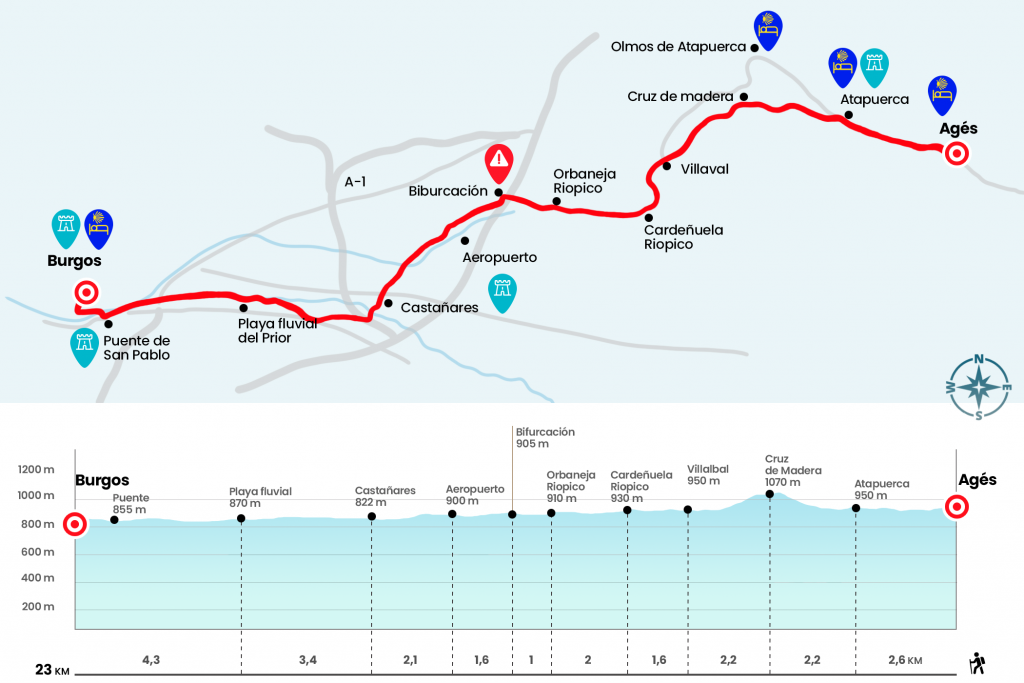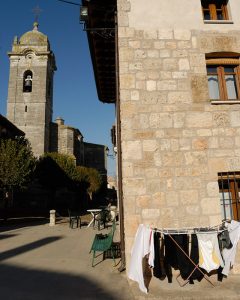Article translated by an automatic translation system. Press here for further information.
Phase from Agés to Burgos
23 kilometers of simple pilgrimage and compulsory stop in Atapuerca
Information about the stage 12: Phase from Agés to Burgos

Enlarge map
Points of interest in the stage 12: Phase from Agés to Burgos
The route
- Km 0. Agés (Hostels. Store. Bar)
We dismissed Agés by taking a final look at his traditional architecture and started the journey through the arcén of the highway that leads to Atapuerca, an island in the ocean of time, as defined by researchers working in the nearby archaeological sites.
- Km 2.6. Atapuerca (Hostels. Bars. Store in season)
The road divides the population into two and acts as the main street. Before leaving the village we left the asphalt and turned left onto a stony track. It moves between low mountain and after leaving
a rough agricultural farm unhindered - not for cyclists - to a large wooden cross (km 4.8).
A yellow arrow at the base of the post encourages us to stay parallel to the dilapidated fence. A geodesic vertex - at an altitude of 1077 meters - marks the beginning of the descent towards the Pico River valley. In the nearest background a quarry is discovered and more in the background the city of Burgos. On the downhill we take, on the left, the crossing that heads up to Villalval.
- Km 7. Villalval
With the scene of the collapsed church we left the town on a local road that leads us shortly to Cardeñuela Riopico, which in spring 2014 already had three hostels of pilgrims.
- Km 8.6. Cardeñuela Ríopico (Hostels. Bars)
Two kilometers later we arrived in Orbaneja. In 2013 the town premiered a pilgrim reception center.
- Km 10.6. Orbaneja Riopico (Hostel. Bar)
We continued down the road and passed over AP-1. In short, about two hundred meters away and together with a few family members, we find a doubling.
The front-facing moves towards Villafría and the one deviating to the left (marked with painting with the Rio option) heads to Castañares (Km 11,6).
Choose which to follow. The Villafría de Villafría is heavier, as it takes many kilometers to the capital at the foot of the N-1 and passes through an industrial and extremely urban landscape. Castañares is the best alternative. By this we turn left hand on the dirt track and walk between traces of tailings until we hit with a wash
from the airport, which establishes its security perimeter (Km 13,2). Glued to the fence, we continued to the same
Castañares, at the foot of the N-120.
- Km 15.3. Castañares (Bar. Store. Tourist information at the bar-restaurant Peregrina-T)
From Castañares, the logic and signaling impose following to Burgos by the andadero of the N-120, who previously passes through Villayuda. However, there is a much more appealing alternative that avoids the tedious entry to capital. It is a question of taking the river promenade of the Arlanzón River, which takes quietly to the very centre of Burgos. It is not historic and the purists of the Camino do not support it, but it is gaining supporters. It starts on a pedestrian bridge over the Burgese river. If we have doubts, it is best to ask a neighbor from Castañares. Walking by the river for more than three kilometers we will reach by the beach Fuente del Prior (Km 18,7).
The same walk will take us some forty more minutes to the San Pablo Bridge or Cid Bridge, recognizable by the sovereign medieval sculptures that adorn their pillars (Km 22). Crossing the bridge we access El Cid Square, where is the equestrian sculpture of this notable figure of the Reconquista. After passing the statue we took the walk of the Espolón to access the stoning
of the Cathedral. Behind this summit monument of the Gothic, on the 28th of Fernán González Street, is the municipal hostel.
- Km 23. Burgos (All Services)
The difficulties
Remarks
In images
What to see, what to do
The hostels

¿Do you want to send any photo of "The Camino de Santiago"?
If you have any photos of "El Camino de Santiago" that you want to share with us, you can send them to us and enlarge the photo gallery


Forum: What pilgrims think about the Camino de Santiago
See all